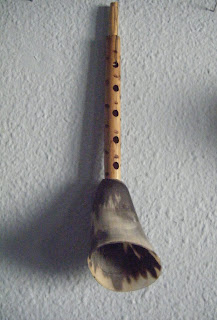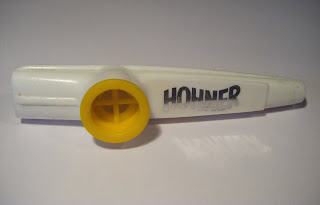India, Sri Lanka, Tunisia

HARMONIC- is played by blowing or sucking air on its individual holes or multiple holes at once. The pressure caused by blowing or vacuum in the chambers of the tabs causes them (brass or bronze) to vibrate up and down creating sound.
 SHANAI - Aerophone Indio. Wood and brass. It is used in celebrations such as weddings and processions in Northern India to bring good luck. It is a wooden tube that gradually widens towards the lower end finishing in a metal part as a trumpet. It consists of a double reed made payola to make it a quad cane wood and usually have between 6 and 9 holes depending on its length. They usually come with different types of nozzles, to achieve different sounds.
SHANAI - Aerophone Indio. Wood and brass. It is used in celebrations such as weddings and processions in Northern India to bring good luck. It is a wooden tube that gradually widens towards the lower end finishing in a metal part as a trumpet. It consists of a double reed made payola to make it a quad cane wood and usually have between 6 and 9 holes depending on its length. They usually come with different types of nozzles, to achieve different sounds. small reed flute. Fa tuning.
 METAL FLUTE.
METAL FLUTE. Irlanda.etal chrome tuning Fa. Widely used in the Celtic music.

HORN FLUTE - Tunisia.
bamboo cane, horn termination emplificar
sound
straight Trumpet Moorish like the Roman tuba,
which was also used in Castilla

QUENA: Aerophone Sudamericano. 6 Holes and 1 posterior. Acacia wood is a flute of South America and used in countries like Peru, Bolivia, Argentina, Chile or Ecuador. It is the most important Andean folk music. It was played at the Inca empire, and today is used in celebrations, in religious services in Creole music groups, symphony orchestras, etc. One of the particularities of this instrument is the notch, notch or chamfer, of which there are different types: U, C, V, rectum, etc., Still quite difficult to get a sound.

MOCEÑO-Flute of the Andes, s sizeable built in sugarcane. Equipped with 5 orifices on the anterior face, gives bass while sweets. Due to its length, is blown attached via a rod parallel that makes the air from reaching the mouthpiece of the instrument. To touch is registered as a flute, from the air in the lower to the higher pole is the one with the hole for the intonation

MOCEÑO

MOCEÑO
 - VIETNAMESE FLUTE - Cane It has a sound with a very peculiar vibration due to the type of mouthpiece to play since it is embedded in a piece of brass rod that was has practiced cut a V To play it must be kept in position trnsversal, rattling the mouth of brass.
- VIETNAMESE FLUTE - Cane It has a sound with a very peculiar vibration due to the type of mouthpiece to play since it is embedded in a piece of brass rod that was has practiced cut a V To play it must be kept in position trnsversal, rattling the mouth of brass. 
TARKA- Bolivia is an instrument, is made of carved and painted by hand, its sound more melancholy than that of a flute and emulates the sound of wind running through the Bolivian highlands.
 -Been- Aerophone India.
-Been- Aerophone India. 
Been- Aerophone Indio. It's pumpkin, rods and resin. Used by snake charmers in countries like India, Pakistan, Sri Lanka, etc., This is Sri Lanka, decorated with masks typical of the island center driven away the spirits.

faute SWEET- also call recorder, is an ancient wind instrument. Popular from the late Middle Ages to the Baroque, was relegated its use to develop the classical orchestra, full of sound instruments. As the twentieth century back to the museums, in principle, in the interest of interpreting the Renaissance and Baroque music with original instruments, but its global spread is based on the pedagogical possibilities as a tool for initiation Music.
 of Australia is an instument that emulates the sound of the wind. You take one end of the stick to which is attached a rope, which is subject to a fine piece of wood, which when rotated around the body, in its clash with the wind makes the sound
of Australia is an instument that emulates the sound of the wind. You take one end of the stick to which is attached a rope, which is subject to a fine piece of wood, which when rotated around the body, in its clash with the wind makes the sound  Indian- BHOMPU Aerophone
Indian- BHOMPU Aerophone paper plastic membrane that vibrates through the air to produce sound
 OSUMPOTAN - Body mouth-Thailand. It is a hollow gourd with several reed pipes of various sizes, with holes at different heights
OSUMPOTAN - Body mouth-Thailand. It is a hollow gourd with several reed pipes of various sizes, with holes at different heights
 PAN FLUTE
PAN FLUTE

 OSUMPOTAN - Body mouth-Thailand. It is a hollow gourd with several reed pipes of various sizes, with holes at different heights
OSUMPOTAN - Body mouth-Thailand. It is a hollow gourd with several reed pipes of various sizes, with holes at different heights PAN FLUTE: Aerophone Sudamericano. Panpipes or flutes of Pan are wind instruments composed of several hollow rods covered by a sound-producing fluted end, of course long rods produce lower sounds, and short the most acute. It is a very present throughout the folklore of the Andes.
 PAN FLUTE
PAN FLUTE 
OCARINA- Small wind instrument made of different materials now, but in this case, mostly ceramic, is an instrument without keys and with a range from 2 holes to push to 12, addition of double and triple up to 24 holes.
The timbre varies according to the size of the instrument, it is noteworthy that the sound is generated equal to the recorder but it works differently, because while the flute tone gives the distance from the mouth of the hole or key in ocarina tone depends on the relationship between air volume and free holes. Its origin dates from ocarina America Pre-Columbian, the Quechua and Aymara used musical instrument, accompanied by flutes, panpipes and other instruments.
The timbre varies according to the size of the instrument, it is noteworthy that the sound is generated equal to the recorder but it works differently, because while the flute tone gives the distance from the mouth of the hole or key in ocarina tone depends on the relationship between air volume and free holes. Its origin dates from ocarina America Pre-Columbian, the Quechua and Aymara used musical instrument, accompanied by flutes, panpipes and other instruments.









0 comments:
Post a Comment